
At Kaizen Aquatics, we take on a 3 pronged approach to teaching children.
- Small Class Size (4 or less) to optimise learning for the child by allowing for maximal attention from the instructor.
- Identifying the learning styles of the children to increase the effectiveness of lesson delivery. We identify the children learning styles based on Fleming’s “VARK model”, which categorizes the various learning styles into visual, auditory ,kinesthetic/tactile learners. By identifying correctly the various learning styles, appropriate approaches to teaching the strokes can be implemented. Such methods though tedious results in efficient yet effective learning.
- Fun. Keeping the lessons enjoyable for the children is a necessary process to reduce the overwhelming feeling of overcoming fear (of water) especially for children. We use, games, toys, challenges, mini competitions to teach and increase participation and interest in swimming.
Through these approaches, swimming can be learnt in an effective yet enjoyable manner for children!
Approach for Kids Program
Kaizen Aquatics uses a 5 Step approach to develop children from Beginners (non-swimmers) to being Water-safe and Competitive Swimmers
Phase 1 Play and Identifying Learning Styles
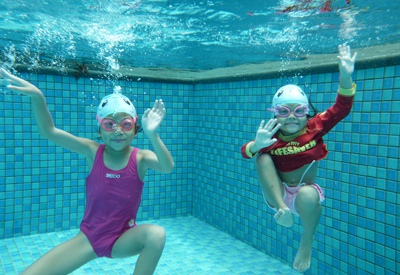
Children who are new to swimming are usually fearful of submerging their head in the water. This desired outcome can be achieved by first letting the child enjoy being in the water and for the child to look forward to coming for the swim lessons. Only then can an accelerated rate of learning take place.
During this phase children also build trust with their coach and the trust is critical because it will be called into play when children are asked to do activities or task which they might be fearful of. When the child is able to trust that the coach will ensure that they are safe then only will he or she be willing to try activities or tasks that take him or her out of their comfort zone.
In addition, during this phase, the coaches will identify the various learning styles each child is inclined to. Broadly categorised into Kinaesthetic, Auditory and Visual learner styles, each child is able to learn most effectively when the correct learning style is being used. Hence, having identified the learning styles, the coach can then adjust his or her method of instruction to be customised to each child.
Phase 2 Kicking and Confidence
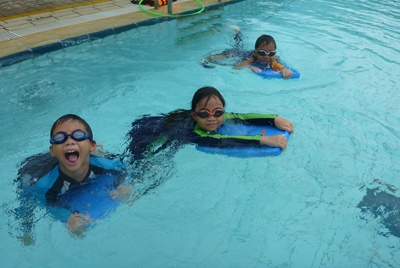
The 2nd Phase involves building confidence though basic movement in the water. At this stage children will require a floatation device, usually in a form of a Kickboard or Flotation Belt. Initially certain children may exhibit fear of leaving the wall even with floatation devices however, with the Kaizen Approach; every child will definitely be able to overcome this.
Once the child has gained enough confidence to leave the wall, he or she will be given many opportunities to move without the aid of an instructor through the use of activities and games. It is from our experience to note that children usually have little trouble leaving the wall but take some time to develop the necessary neuromuscular coordination and develop the basic leg strength to perform an effective kick.
At Kaizen Aquatics we do not cut corners here because a good kick can assist a child greatly in the subsequent phase which will involve swimming. It is great to note that when children progress past stage 2 they are brimming with confidence and usually progress fast into the skills in stage 3.
Phase 3 Swim and Save
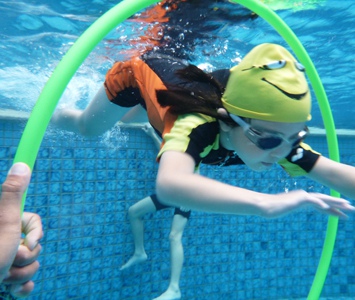
In the 3rd Phase, children will learn the basic strokes of Freestyle and Breaststroke. Once being able to swim at least 1 stroke proficiently. They will do water confidence activities and survival skills such as threading water, identifying risks and basics non-contact rescue.
The 3rd Phase is usually the phase where children spend the longest time because of the high technical difficulty of swimming the 2 strokes proficiently. Though this phase takes time, it is extremely necessary and critical that the time is spend because building good stroke foundation for children at a young age ensures that they do not have to go through the whole process of unlearning the simplified strokes frequently taught and relearning what strokes that are efficient and technically sound at a later stage.
Phase 4 Strokes and Skills
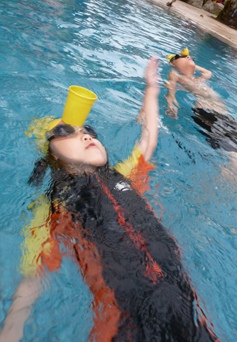
In the 4th Phase, children are already competent with swimming the 2 basic strokes of freestyle and breaststroke. There can be no better a time to learn the 2 other FINA recognised strokes namely Butterfly and Backstroke. In addition the survival backstroke a modified form of backstroke will also be taught to prepare them for the Swim safer Skills Test which will happen in the next phase of their learning.
Concurrently during this phase survival skills such as safe entry methods, correctly doing a dive entry, making floatation with normal clothes, learning how to fit on a lifejacket in water will also be taught. They will also learn water movement skills like the forward and backward tumble turn and depth control which consists of swimming underwater a distance and being able to retrieve objects from the base of the pool.
Phase 5 Stroke Correction, Certification and Competition
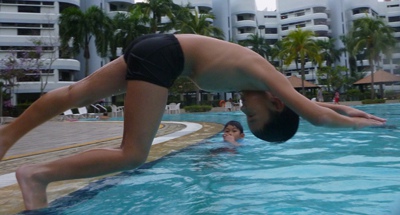
In the 5th Phase, children should be able to swim 4 strokes competently; hence it is best that lessons now focus on developing the best strokes for the child. So some may choose to take on swimming at a competitive level subsequently, good stroke development helps bridge the gap between a beginner swimmer and a competitive swimmer.
Concurrently, your child will be consolidating the entire repertoire swim skills learnt in previous phases before going on to taking certifications in swimming offered by Singapore Sports Council. Kaizen Aquatics subscribes to the swim safer program and will develop the child to complete successfully all the 6 stages in the program. The details of the test can be obtained from the Singapore Sports Council Website or form a Kaizen Aquatics Coach.
In developing the young swimmer, Kaizen Aquatics will make use of a series of drills which have been adequately modified to suit the young swimmer. With good instruction and attention, children can achieve a very efficient stroke which should be the desired outcome for any parent.
